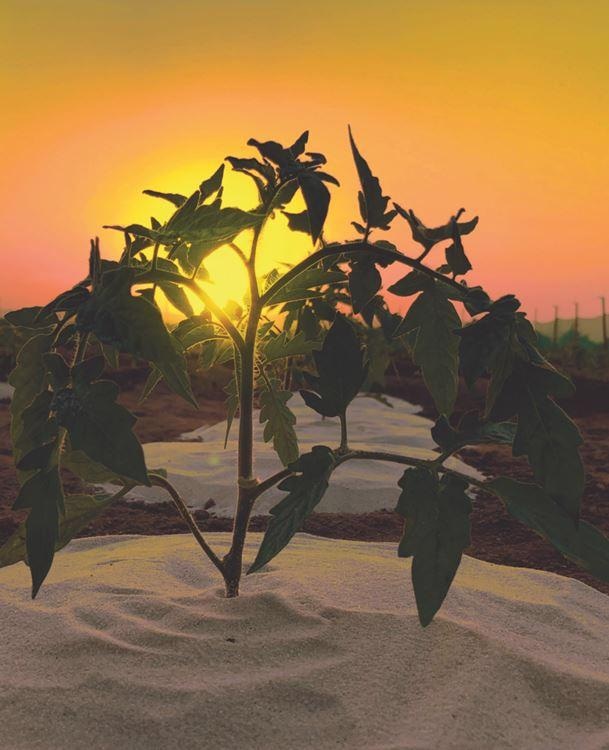Reviewed by Alex SmithApr 25 2022
A nature-inspired wax-coated sand has been developed to help improve the production of food in the desert because freshwater resources are depleting.
 Using a highly hydrophobic layer of sand as a mulching material reduces soil evaporation and enhances crop yield significantly. Image Credit: © Adair Gallo Jr.
Using a highly hydrophobic layer of sand as a mulching material reduces soil evaporation and enhances crop yield significantly. Image Credit: © Adair Gallo Jr.
A number of dry countries are undergoing serious water security issues. In desert areas like Saudi Arabia, dry winds and high temperatures speed up evaporation from the soil and intensify transpiration from plants, which therefore need additional water to preserve their suitable temperature and soak up nutrients.
Farmers depend upon unmaintainable levels of irrigation to match their crops’ intensified evapotranspiration requirements.
“With over 70 percent of the country’s freshwater resources used for agriculture, groundwater aquifers that supply 90 percent of irrigation water are being irreversibly depleted,” says Kennedy Odokonyero, a postdoctoral researcher at KAUST in Himanshu Mishra's team.
In certain dry countries, plastic sheets are employed to inhibit evaporation, but the plastic ultimately gets thrown into landfills.
In 2016, Himanshu Mishra and his contemporaries created superhydrophobic sand (known as SandX), a bio-stimulated material containing grains of sand or sandy soils that were coated in a nanoscale layer of paraffin wax. The roughness of the sand integrated with the innately impermeable wax formed a highly waterproof (superhydrophobic) surface.
A 5-10 mm thick layer of SandX applied like mulch over wet soil greatly reduces evaporation.
Himanshu Mishra, Study Lead, KAUST
Four-year field research of SandX mulching of wheat, tomato and barley plants in western Saudi Arabia revealed that “SandX significantly improved plant health, size, and yield under normal irrigation,” he says, “but the specific physiological factors underlying these results were unclear.”
Additional research by Mishra's team examined the effects of SandX on tomato plants (Solanum lycopersicum) grown in regulated, desert-like settings together with a group of unmulched tomatoes for the purpose of comparison. They monitored plant size, water use and the physiological health of the shoots, roots and fruits of the plants under regular and minimal irrigation.
Extraordinarily, the combined transpiration and evaporation budget stayed the same in both mulched and unmulched plants. Nonetheless, SandX mulching decreased evaporation losses by approximately 80%, which improved transpiration and helped the plants under both irrigation settings.
Mulched plants had a significantly wider root xylem, the vessel that transports moisture and minerals from the root through the stem, which improved water and nutrient uptake from the soil.
Kennedy Odokonyero, Postdoctoral Researcher, KAUST
Furthermore, just as the team noticed in their field trials, the fruit harvests of the mulched tomatoes were about 30% higher than the unmulched equivalents.
SandX could offer a sustainable solution for excessive water consumption.
Kennedy Odokonyero, Postdoctoral Researcher, KAUST
Field tests are already happening on various native trees and crops in Saudi Arabia, and the researchers have started expanding SandX production with funding through an Innovation and Economic Development grant from KAUST.
“Our technology will contribute to food production and greening projects in arid regions across the Middle East and beyond,” concludes Mishra.
Journal References:
- Odokonyero, K., et al. (2022) Effects of superhydrophobic sand mulching on evapotranspiration and phenotypic responses in tomato (Solanum lycopersicum) plants under normal and reduced irrigation. Plant-Environment Interactions. doi.org/10.1002/pei3.10074.
- Gallo Jr, A., et al. (2022) Nature-inspired superhydrophobic sand mulches increase agricultural productivity and water-use efficiency in arid regions. ACS Agricultural Science & Technology 2. doi.org/10.1021/acsagscitech.1c00148.